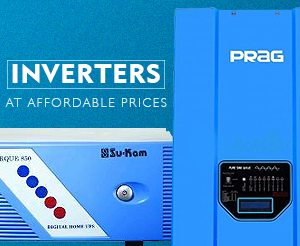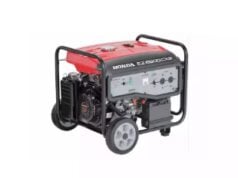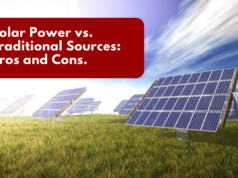 Inverter is a circuitry or electronic device which converts Direct Current (DC) into Alternating Current (AC). The inverter conversion has to do with the energy from battery source to the type of energy/voltage supplied to the home from the utility or power station.
Inverter is a circuitry or electronic device which converts Direct Current (DC) into Alternating Current (AC). The inverter conversion has to do with the energy from battery source to the type of energy/voltage supplied to the home from the utility or power station.
Basically; Direct Current (DC) which is what inverter is converting from is the type of energy stored in the batteries which is being converted to Alternating Current (AC) energy i.e. the type of energy that is being produced by the power station or company and found in the homes to run household/electric appliances such as stereo, television sets, refrigerator etc. Hence an inverter is needed to turn the energy into a utilizable form.
Inverters are used for many applications. Specifically, in situations where low voltage DC sources such as batteries, solar panels must be converted so that devices can run on AC power. For instance, converting electrical power from a car battery to run a laptop, TV set, cell phones etc but with the inverter technology such direct current can be converted.
It should however be noted that Electrical Inverter which is usually called power inverter = DC & AC Power Inverter.
Functions of Inverters
Primarily, the ultimate function of an inverter is to convert Direct Current (DC) into well utilizable Alternating Current (AC). This is because the power supplied to Industry and homes by the main power grid or public utility is AC. This unique function perform by the inverter makes it possible for stored current to be reconverted for used at home, office, shops and any other place one wish to use it. Sizes of Inverters
The sizes of inverter range from as low as 100 Watts to as high as over 5000 Watts. This size rating indicates that the capacity of an inverter can concurrently and continuously give away or supply effective power transmission output voltage and frequency to high wattage combination of equipment and appliances.
The sizes of the inverter will also affect the possible load that can be placed on it. If you are willing to have an inverter with only few of your device in your home, the power input will determine the inverter size that you will want to buy. If you are using inverter for large power purpose, then you will need high watts of inverter alongside the battery or source.
Buying Power Inverter
Power inverter purchase can be a difficult and an easy one. Power inverter can be brought from both offline and online shop. It is basically good to get ones power inverter from a very good source because it will enable one to have good information about the inverter one is buying and there will be a wonderful support from the seller.
To buy power inverter one can get it from www.kara.com.ng where one will have access to different types of inverters, good advice on which one to get for the purpose such inverter will serve. Furthermore, power inverter will also work very well when it is install by the professionals it will serve better.
Price of Power Inverter
The price of power inverter is usually affected by the watt of the inverter as well as the manufacturer of the inverter. Power inverter price ranges from 16,000.00 to 2,875,000.00 on www.kara.com.ng.
Conversion Methodology of Inverters
The conversion process of inverter is completed in two steps, the first is the conversion of the low voltage DC power to a high voltage DC source after which the high DC source is converted to an AC waveform using pulse width modulation.
In other words, the low voltage DC power is first converted to AC by the inverter, and then a transformer is used to boost the voltage to 120 volts.
Applications of Inverter
Power inverters are electronic devices which convert electrical energy of battery source i.e. Direct Current (DC) into that of utility company source i.e. Alternating Current (AC). They come in varying shapes and sizes, from low power functions to backing up current storage in case of power outage.
Typical applications for inverters include:
Power generation systems such as electric utility companies or solar generating systems to invert DC power to AC power.
Portable consumer devices that allow the user to connect a DC power source (battery), or set of batteries, to a device or sets of devices to produce AC power to run various electrical gadgets such as home appliances viz lights, televisions, kitchen appliances, and power tools.
For engineering needs to be attained; inverters are applied for larger electronic systems to be functional.
Purpose of Inverter
The purpose of a power inverter is to take DC power supplied by a battery, most often in 12 volts and transform it into a 120 volt AC power source operating at 60 Hz, to suit its function of energy supply, emulating the power available at an ordinary household electrical outlet.
Therefore, inverter as a device has it features with respect to its varying sizes, capacities, varieties, types and in differing prices. Thus, the size, type capacity and variety of an inverter dictate its price. Hence, the features of an inverter are a function of its set purpose.
Types of Inverter
Conventionally, it is popularly accepted that power inverter has two types which are the Modified Sine Wave Inverter or Quasi Sine Wave Inverter and True Sine Wave Inverter or Pure Sine Wave Inverter.
The Modified Sine Wave Inverter (or Quasi Sine Wave Inverter) is the simple and most common type of inverter which requires and accepts home and electric appliances application and usage. Considering its waveform it gives useful rough approximation with irregular square current flow.
The true Sine Wave Inverter (or Pure Sine Wave Inverter) is a power inverter which produces smooth sinusoidal AC waveform. It is complex in structure and features which makes it more expensive to purchase. It is appropriately reserved for medical treatment equipment use and other sensitive sound and audio equipment.
Process of Installation of Inverter
The success of a DC to AC power inverter installation is a function of the methods and materials used.
The processes of inverter installation are as follows;
Mounting the inverter
Fuse Holder Installation
Battery Installation Compartment
Mounting the Battery
Direct Current (DC) wiring among others.
The fundamental materials needed to install the inverter are;
Distribution Board (DB)
Change over switch
Cables
Batteries (with respect to capacity).
Inverter Ratings
Inverters have three basic ratings, and you may consider the inverter rating best suited to your particular requirement when selecting one.
Surge Rating – Some appliances, such as refrigerators and TVs, require a high surge to start functioning. However, they will need significantly less power to continue running. Therefore, an inverter must have the ability to retain its surge rating for a minimum of 5 seconds.
Continuous Rating – This describes the continuous amount of power you can expect to utilize without causing the inverter to overheat and possibly shut down.
30-Minute Rating – This is useful where the continuous rating may be far below the level required to power a high energy-consuming piece of equipment or appliance. The 30-minute rating may be adequate if the appliance or equipment is only used occasionally.
Inverter Related Terms
Watt (W)
Watt is the measure of how much power a device uses when turned on or can supply. If a device uses 100 Watts, it is simply the voltage multiplied by the current value. For example, if the device takes 10 Amps at 12 Volt DC, it uses 120 watts power. That is 10A x 12 V = 120 W.
Watt Hour (WH)
A watt hour (or Kilo Watt hour kWh) is simply how many watt times, how many hours the device is used. If the device uses 100 watts for 10 hours, it is 1000 watt hour or 1 kWh. The electricity tariff is based on kWh.
Ampere (A)
It is the measure of electrical current at the moment. Amps are important to determine the wire size for connecting the inverter to the battery. Low gauge wire will heat up and burn if heavy current flows through it from the battery.
Ampere-Hour
Amp-Hour usually abbreviated as AH is the Amps x Time. AH is the measure of battery capacity which determines the backup time of the inverter.
Volt Ampere
It represents the maximum load capacity of the inverter. Commonly available inverters are 500 A, 800 VA, 1000 VA, 1500 VA etc.
Inverter Working Process
When there is power supply:
The energy (AC) source is available; the inverter charger conditions it (AC), before passing it to your equipment and simultaneously charges your batteries.
Power supply from power station or utility company is AC and converted into DC by the Inverter and stored in the battery.
The inverter is the brain and power that does the energy conversion.
Current in AC utility company is converted by Inverter to DC and stored in battery
When there is Power outage:
Inverter charger automatically switches to battery back- up
It converts stored DC power to regulated AC power.
Explicitly, when there is light disruption, the inverter release charged energy (DC) back to AC to be used by home appliances.
Battery releases DC to Inverter and converts to AC to be used by home appliances.
Ten Benefits of Inverter
The benefits of an inverter cannot be over-emphasized, these benefits entails;
Inverter provides stable output voltage to protect your equipment and help it perform at its peak.
When AC power source generates voltages too high or too low for safe operation, the charger acts as an intermediary.
It corrects unsafe voltage levels before AC power reaches the equipment.
Inverter also correct output frequency.
It allows sensitive equipments like Computers, and Electronics to operate without malfunction.
Inverter provides clean, safe and reliable power to your equipment
When the AC source is unsafe, unreliable, or unavailable, inverter protects the equipments
Zero servicing and running cost
It guarantees safer and healthy working since it doesn emit gases that are harmful and destructive to human environment
It is costing and timing efficient with respect to servicing, maintenance and working processes and procedures.
Maintenance of Inverter
Inverters can be adequately maintained when its rules, regulations and cautions are strictly adhered to. This in turn prolongs and boosts its effective usage and performance. The guides to follow are under listed below;
Cautions on Inverter
Use energy saving bulbs
Put off light and other gadgets that are not in use to conserve energy
Ensure that you take note of the indicator light (Red, Orange, and Green)
Take note when energy is high, medium or low
It should be turned off when it is fully charged and when very low.
Inverters can get spoilt when:
You allow it to shut down on its own
There is too much load on it i.e. more than enough voltage it can bear or power.
There is no cross – ventilation.
Water penetrates into the panel unit
There is an improper connection
The rack is not strong enough to withstand the weight and it falls down
It is not charged periodically
Charged with generator of less capacity source of power.
It will be a better life if you get a power inverter to generate uninterrupted supply in your office or home. With power inverter you will save more and get high level of power usage. Power inverter will reduce your concurrent spending on power generation as well as improve the power supply to in your home and office. You have no other option that to get a power inverter today to live a better life. Order yours now at www.kara.com.ng










